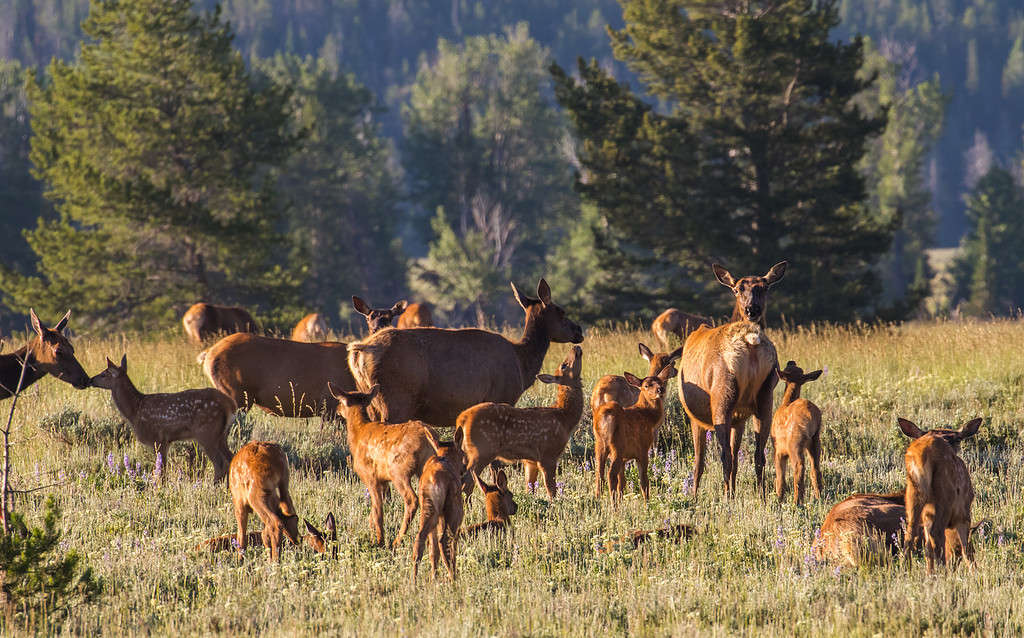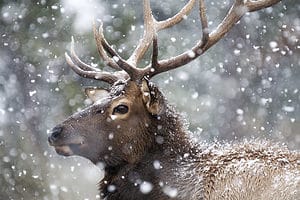Elk are herbivores, which means that they are typically unaggressive. They spend their time grazing peacefully and don’t show aggression unless provoked in most cases. However, what’s provocative to an elk is often not the same as what we consider threatening. Therefore, if you encounter an elk, it’s important to know how to avoid upsetting them.
Furthermore, elk are wild animals. They aren’t domesticated, and their behaviors can be unpredictable. Some elk may be more prone to becoming aggressive than others, and certain factors increase the odds of an elk becoming aggressive.
We’ll review these factors below and cover how to avoid being the victim of an elk attack.
Factors that Increase Elk Aggression

Calving season is the most dangerous time for elk viewing, as they become very protective of their babies.
©Nathan McDaniel/iStock via Getty Images
Many factors may make an elk more likely to attack and become aggressive. Some of these factors you can control, while others are out of your hands. Still, it’s important to be aware of them to determine how dangerous elk in your area may be properly.
The biggest driving factor of aggression is the presence of calves. If it is calving season, there is a chance the newborn calves will be around. Typically, an elk’s response to feeling threatened is to run away. However, a newborn calf may be unable to do this. Mother elk are very protective and may become aggressive if they think you’re threatening her calf.
It is best to stay very far away from elk if you notice any calves.
Mating season can also cause aggression, as elk become more agitated and territorial during this time. Tense is high, and you may end up the reliever of some of this tension! Often, this occurs in September and October, so give elk an extra-wide berth during this time.
Dogs (especially large ones) can also cause aggression. Elk see dogs as predators, while they may not apply this reasoning to people. Simply put, dogs scare elk, and a scared elk is far more likely to become aggressive. Even if the dog isn’t acting aggressively, its mere presence can cause fear. An anxious elk will pull its ears back and sometimes grind its teeth.
Therefore, we highly recommend leaving your dogs home if you plan to view elk. If you run into elk when you have your dog, leave the area right away.
As we said above, elk prefer running away when scared. If an elk cannot do that, they’re more likely to charge you and become aggressive. Be aware of natural boundaries, like steep terrain and creeks, as elk may decide that charging you is easier than crossing this terrain. Never corner an elk or follow it after it leaves an area.
In some areas, elk regularly come into contact with people. Regular contact increases an elk’s familiarity with people, which may make them less aggressive. Elk may be more likely to feel aggressive and react appropriately in areas where humans aren’t as common.
That said, no elk is domesticated. Therefore, don’t assume that an elk won’t be aggressive just because it is regularly around people.
Staying Safe Around Elk

Keep a safe distance between you and any elk you see, especially if babies are present.
©SBTheGreenMan/iStock via Getty Images
Viewing elk can be a magnificent experience. However, you should always take precautions to ensure everyone’s safety.
Always stay at least 100 feet from any elk. Elk can quickly feel threatened if you get any closer. You may want to stand even further away during calving and mating season.
Never approach an elk or calf. Calves may lay on the ground while their mother moves around to eat. When you see a calf lying by itself, that does not mean the mother abandoned their baby. If the mother sees you approach, the odds of her becoming aggressive are very high.
If you think you found an abandoned calf, contact the proper authorities. It’s never safe to approach the calf yourself.
While viewing elk, don’t make any sudden movements. These can cause the elk to become fearful, causing aggressive behaviors. Be exceptionally cautious if you accidentally get too close to an elk. It’s best to back away slowly without running.
If an elk does charge you, don’t run away. Elk will often keep running and end up trampling you. You cannot outrun them.
Instead, stand still and make yourself look as large as possible. If you don’t act scared, the elk will second-guess its charge. Don’t back away. Make the elk back away first.
In serious situations, bear spray can work as a deterrent for aggressive elk. If elk are typical in your area, we recommend having a can of bear spray on you whenever you go hiking.
The photo featured at the top of this post is © Georgia Evans/ via Getty Images
Thank you for reading! Have some feedback for us? Contact the AZ Animals editorial team.







